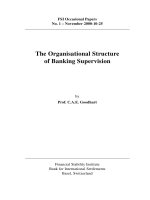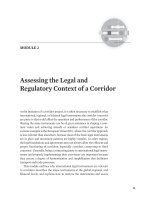Lecture Legal and regulatory aspects of banking supervision – Chapter 6
Bạn đang xem bản rút gọn của tài liệu. Xem và tải ngay bản đầy đủ của tài liệu tại đây (83.78 KB, 41 trang )
Session: SIX
MBF-705
LEGAL AND REGULATORY
ASPECTS OF BANKING
SUPERVISION
OSMAN BIN SAIF
Summary of Previous Session
•
Sub Prime mortgage: the main cause of
banking crisis 2008
–
•
Story telling
General Principles of Bank Regulations
2
Agenda of this session
•
General Types of Bank Regulations
•
Privacy Regulations
•
Anti-money laundering and anti-terrorism
regulation
•
Community re-investment regulation
•
Deposit account regulation
•
Deposit insurance regulation
•
Consumer protection
3
Agenda of this session (Contd.)
•
Interest on demand deposits
•
Lending Regulations
–
Consumer protection
–
Debt collection
–
Credit cards
–
Lending limits
•
Central bank regulations
•
Regulation of bank affiliates and4 holding
Types of Regulations
•
Banks in one form or another have been
subject to the following non exhaustive list
of regulatory provisions:
1)
restrictions on branching and new entry;
5
2)
restrictions on pricing (interest rate controls
and other controls on prices or fees);
3)
line-of-business restrictions and regulations
on ownership linkages among financial
institutions;
6
Types of Regulations (Contd.)
4)
restrictions on the portfolio of assets that
banks can hold (such as requirements to
hold certain types of securities or
requirements and/or not to hold other
securities, including requirements not to hold
the control of non financial companies);
7
5)
compulsory deposit insurance (or informal
deposit insurance, in the form of an
expectation that government will bail out
depositors in the event of insolvency);
6)
capital-adequacy requirements;
8
Types of Regulations (Contd.)
7)
reserve requirements (requirements to hold a
certain quantity of the liabilities of the central
bank);
8)
requirements to direct credit to favored
sectors or enterprises (in the form of either
formal rules, or informal government
pressure);
9
9.
expectations that, in the event of difficulty,
banks will receive assistance in the form of
“lender of last resort”;
11.
special rules concerning mergers (not always
subject to a competition standard) or failing
banks (e.g., liquidation, winding up, insolvency,
composition or analogous proceedings in the
banking sector);
10
Types of Regulations (Contd.)
11)
other rules affecting cooperation within the
banking sector (e.g., with respect to payment
systems).
11
Privacy Regulations
•
Regulation P governs the use of a
customer's private data. Banks and other
financial institutions must inform a
consumer of their policy regarding
personal information, and must provide an
"opt-out" before disclosing data to a nonaffiliated third party. The regulation was
enacted in 1999.
12
Anti-money laundering and antiterrorism Regulation
•
The Bank Secrecy Act (BSA) requires
financial institutions to assist
government agencies to detect and
prevent money laundering.
13
Anti-money laundering and antiterrorism Regulation (Contd.)
•
Specifically, the act requires financial
institutions to keep records of cash
purchases of negotiable instruments, file
reports of cash transactions exceeding
$10,000 (daily aggregate amount), and to
report suspicious activity that might
signify money laundering, tax evasion or
other criminal activities.
14
Community reinvestment
Regulation
•
•
The Community Reinvestment Act of 1977
requires insured depository institutions to
reinvest in the communities they serve.
There should be an emphasis on lowincome and moderate-income (LMI)
census tracts and individuals.
15
Community reinvestment
Regulation (Contd.)
•
Insured depository institutions must
display a CRA notice, and each branch
must have a current CRA public file or
access to it via the company's intranet,
and must provide the information in
person or by mail
16
Deposit account regulations
•
Deposit Insurance
•
Consumer protection
•
•
Withdrawal limits and reserve
requirements
Interest on demand deposits
17
Deposit Insurance
•
•
The United States was the second country
(after Czechoslovakia) to officially enact
deposit insurance to protect depositors
from losses by insolvent banks.
In 1933 the Glass–Steagall Act
established the Federal Deposit Insurance
Corporation (FDIC) to insure deposits at
commercial banks.
18
Consumer protection
•
The Truth in Savings Act (TISA),
implemented by Regulation DD,
established uniformity in disclosing terms
and conditions regarding interest and fees
when giving out information and when
opening a new savings account.
19
Consumer protection (Contd.)
•
On passing the law in 1991, Congress
noted it would help promote economic
stability, competition between depository
institutions, and allow the consumer to
make informed decisions.
20
Withdrawal limits and reserve
requirements
•
•
•
Establishes reserve requirement
guidelines
Regulates certain early withdrawals from
certificate of deposit accounts
Defines what qualifies as DDA/NOW
accounts. See Regulation Q for eligibility
rules for interest-bearing checking
accounts
21
Withdrawal limits and reserve
requirements (Contd.)
•
Defines limitations on certain withdrawals
on savings and money market accounts
–
Unlimited transfers or withdrawals if made in
person, by ATM, by mail, or by messenger
–
In all other instances, there is a limit of six (6)
transfers or withdrawals. No more than three
(3) of these transactions may be made
payable to a third party (by check, draft, pointof-sale, etc.)
–
Some banks will charge a fee with22each
Interest on demand deposits
•
Until 2011, Regulation Q prohibited banks
from paying interest on demand deposit
accounts. A "demand deposit" account
includes many, but not all checking
accounts, and does not includeNegotiable
Order of Withdrawal accounts (NOW
accounts).
23
Lending regulations
•
Consumer protection
•
Debt collection
•
Credit cards
•
Lending limits
24
Consumer protection
•
The Home Mortgage Disclosure
Act (HMDA) of 1975, implemented
by Regulation C, requires financial
institutions to maintain and annually
disclose data about home purchases,
home purchase pre-approvals, home
improvement, and refinance applications
involving one- to four-unit and multifamily
dwellings. It also requires branches and
loan centers to display a HMDA 25
poster.









